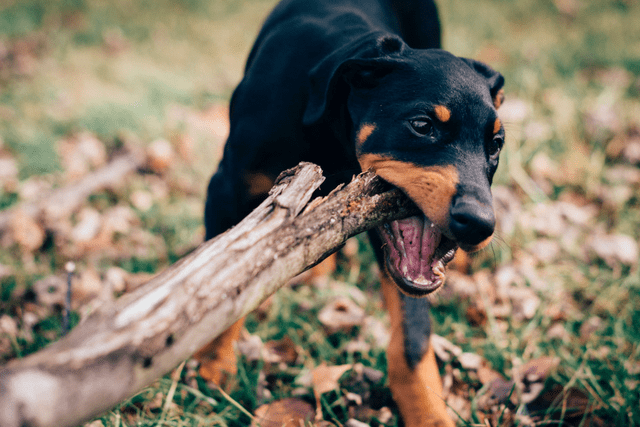
Stick chewers are at risk of a multitude of problems ranging from wood splinters stuck under their gums and other tissues in the mouth to obstruction of their digestive andor respiratory tract with wood. The answer depends on what your dog does with the stick and what kind of wood it is.

A dog with separation anxiety is likely to exhibit a plethora of unusual behaviors and chewing on wood can be one of them.
Can dogs eat wood sticks. This tree is toxic to dogs and might upset their stomachs if they eat the wood from the pine. While the poison isnt fatal for dogs the pine toxics do cause vomiting diarrhea and lethargy. Besides the problems that can occur from pine wood there is also the risk of chemical poisoning as well since many wooden objects like outdoor furniture and stuff are often treated with chemicals that.
Is it safe for my dog to eat sticks. Sticks and Wood The danger though is that the dog begins to use sticks as toys and many dogs will begin chewing on the stickWood splinters easily when chewed on and shards can jam into the dogs mouth causing an infection. Also if pieces of wood are swallowed it can cause intestinal blockage.
It may seem strange to you but there are a number of reasons why your dog eats wood. Its not unusual to see dogs chewing on sticks. Theyre easy to find everywhere and dogs are instinctively attracted to them because they make natural chew toys.
Risks of eating sticks for dogs. There are two main risks for dogs when it comes to popsicle sticks and they are poisonous wood and piercing sticks. The most common issue is that your dog may sustain a stick-related injury when chewing on wood.
It is worth mentioning that if youre playing fetch with a stick it may also cause an injury. Stick-chasing injuries are usually more severe as compared to the stick-chewing injuries. It doesnt mean chewing wont cause other problems your dog may have splinters stuck in tissues in the mouth or chewing on wood.
Many dog owners utilize sticks as a fetching toy when outside on walks and at the park. The danger though is that the dog begins to use sticks as toys and many dogs will begin chewing on the stick. Wood splinters easily when chewed on and shards can jam into the dogs mouth causing an infection.
Also if pieces of wood are swallowed it can cause intestinal. Dogs can tell that there is a difference in taste and texture between a stick and a bone. However sticks have their own appeal their earthy musky taste that seems to appeal to most dogs.
Taste is not the only appealing thing about sticking that stick in your dogs mouth. Monitor your dogs feces watching for signs of wood fragments or the whole stick a good sign or blood a bad sign. Watch for any warning signs like vomiting diarrhea bloody stools lethargy or disinterest in food.
If your dog is behaving abnormally call your vet immediately. A dog with separation anxiety is likely to exhibit a plethora of unusual behaviors and chewing on wood can be one of them. Chewing on wood can be a positively reinforced trait.
When in the park we often play fetch with our dogs and that game usually involves throwing a wooden stick or a wooden branch. By doing this we reinforce our dogs to believe that wooden items and play are. Sticks and Wood The danger though is that the dog begins to use sticks as toys and many dogs will begin chewing on the stick.
Wood splinters easily when chewed on and shards can jam into the dogs mouth causing an infection. Also if pieces of wood are swallowed it can cause intestinal blockage. Fortunately your dog isnt as dirty-minded as my husband.
To your pup this just looks like a stick. Only better the West Paw Zwig has features a basic stick just cant offer. If your dog prefers sticks to balls then this is the ultimate fetch toy.
It can be thrown a good distance and has a satisfying bounce when it lands on short. Why sticks can be harmful. So it is okay for dogs to chew sticks.
The answer depends on what your dog does with the stick and what kind of wood it is. While chewing wood can alleviate teething pain eating or swallowing it can have dangerous consequences. Chewing on a stick that splinters can result in sharp points lodging in your dogs mouth or esophagus and causing tears or infections.
Dog Health Dog Training Dog Grooming Dog Breeds Dog Names Dog Activities Dog Senses Dog Behavior. Sticks abundant and free though they may be truly can pose significant and life-threatening injuries to your dog. Stick chewers are at risk of a multitude of problems ranging from wood splinters stuck under their gums and other tissues in the mouth to obstruction of their digestive andor respiratory tract with wood.
Yes and no. It is ok for a dog to eat sticks if its just chewing and not being swallowed. Many dogs love the feeling of chewing sticks and bark and can even be a stress relief for some.
However it is bad for your dog to eat sticks if they are swallowed. This can lead to blockages in their intestines this could be fatal in the worst-case scenario. Its not really ok for your dog to eat sticks and can lead to.